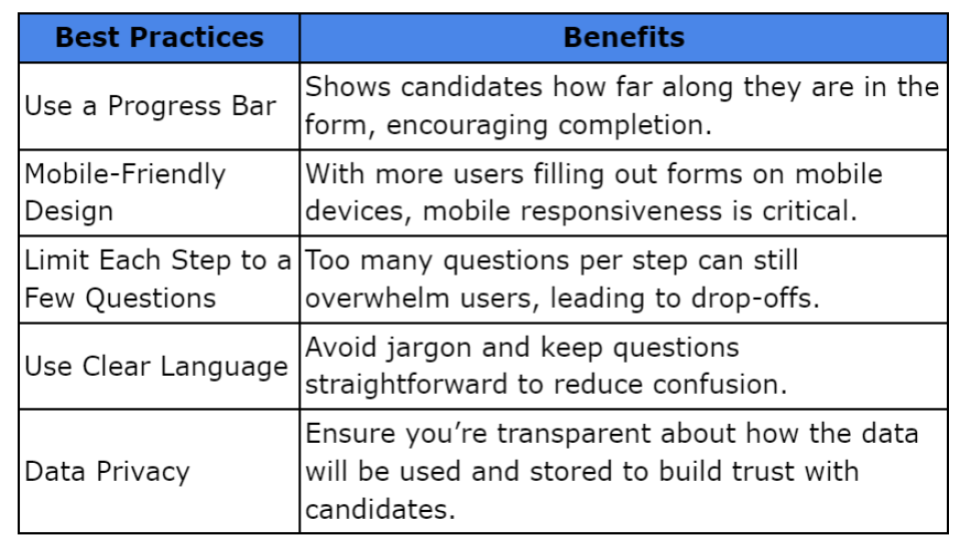How B2B Companies Can Leverage Multi-Step Forms for IT Talent Acquisition
Remote IT teams are becoming the norm rather than the exception. With businesses going global, talent is no longer restricted by geographic boundaries. However, finding and attracting top talent for remote IT positions, especially when you’re trying to hire dedicated Python developers or any other offshore developers, can be challenging.
For B2B companies, leveraging digital tools like multi-step forms is a smart way to streamline the lead generation process. It’s not just about capturing candidates' information; it's about gathering relevant, detailed data that helps companies make smarter hiring decisions. Here's how you can use multi-step forms effectively to generate high-quality leads for remote IT teams through IT staff augmentation.
The Growing Need for Remote IT Teams
Remote work isn’t a trend; it’s a shift in how businesses operate. According to a survey by Upwork, 22% of the American workforce is expected to work remotely by 2025, which is an 87% increase from pre-pandemic levels. This change is particularly notable in the IT industry, where tasks like development, cloud computing, and cybersecurity can be easily managed from anywhere in the world.
IT staff augmentation has emerged as a powerful solution for businesses wanting to hire offshore developers without the overhead of full-time employment. With IT staff augmentation, you can scale your team on-demand, accessing global talent while maintaining control over your project.
But how can companies attract the right kind of talent, especially when it’s scattered across the globe? The answer lies in effective lead generation, and multi-step forms can play a pivotal role in helping businesses achieve that goal.
What Are Multi-Step Forms and Why Are They Effective for Lead Generation?
A multi-step form breaks down a lengthy form into smaller, manageable sections, making it easier for users to fill out. Instead of overwhelming candidates with a long, complex form, you ask for information in steps, ensuring higher completion rates.
Why Multi-Step Forms Work
a. Improved User Experience: Multi-step forms simplify the data collection process by making it less daunting. For example, instead of asking for all details upfront, you can start by gathering basic information like name and contact details and then move on to more in-depth questions about skills and availability in later steps.
b. Higher completion rates: According to a study by Venture Harbour, multi-step forms can increase form completion rates by up to 300% compared to single-step forms. This is because breaking down questions into steps reduces cognitive overload, keeping the user engaged.
c. Targeted Information Collection: By segmenting the form, you can gather more relevant and specific data, such as a candidate's proficiency in certain programming languages or their preference for remote work, before moving on to more detailed sections.
In the context of IT staff augmentation, using multi-step forms ensures that businesses can ask focused questions to qualify candidates early on. For example, a B2B company looking to hire dedicated Python developers can include specific questions about the candidate’s experience with Python, frameworks like Django or Flask, and their ability to work in a remote team.
How B2B Companies Can Use Multi-Step Forms for Lead Generation
When you’re ready to use multi-step forms to hire offshore developers or any other IT roles, following a strategic process is crucial. Here’s a step-by-step guide:
Step 1: Start with Basic Candidate Information
Begin by asking for the candidate's name, email, and phone number. It’s best to keep these questions simple, as the goal is to initiate engagement without scaring away potential candidates.
Step 2: Add Targeted Questions Based on the Role
If you’re looking to hire dedicated Python developers, for instance, include questions about their technical expertise. Here, you can ask:
a. How many years of experience do you have with Python?
b. What Python frameworks are you proficient in (Django, Flask)?
c. Have you worked in a remote development team before?
These specific questions help you gauge whether the candidate is suited for the project before moving forward.
Step 3: Use Conditional Logic for Dynamic Form Fields
Conditional logic allows your form to adapt based on the candidate’s previous answers. For example, if a candidate indicates they have 5+ years of Python experience, you can skip basic questions and dive straight into advanced ones.
Step 4: Include Skill Assessments (Optional)
Including skill assessments or asking for GitHub links and code samples can further filter out unqualified candidates. Many companies use assessments to determine the developer’s real-world problem-solving abilities.
Step 5: End with a Strong Call-to-Action
The last step should always include a clear CTA. This could be an invitation to book an interview or submit their resume for further consideration. A well-designed CTA ensures you don’t lose leads in the final steps of the form.
How Multi-Step Forms Helped a B2B Company Hire Offshore Developers
Let's look at an example to illustrate the effectiveness of multi-step forms better. A mid-sized SaaS company was struggling to hire offshore developers to scale its development team. They needed skilled professionals quickly but didn’t want to compromise on quality.
By implementing multi-step forms for lead generation, they were able to:
a. Filter candidates early: The form's conditional logic filtered out candidates who didn’t meet the required skills, saving the HR team time.
b. Increase lead conversion: With improved form completion rates (increased by 45%), more qualified candidates entered the hiring pipeline.
c. Faster onboarding: The data collected from the forms allowed the team to make faster hiring decisions, shortening the time-to-hire by 30%.
This is just one example of how multi-step forms can be a game-changer for businesses looking to quickly hire dedicated Python developers or augment their IT teams with offshore talent.
How to Optimize Multi-Step Forms for Better Results
Creating the form is only half the battle. Optimizing it for user experience is crucial for driving high-quality leads. Below are some best practices to keep in mind:
The Role of IT Staff Augmentation in Sourcing Remote IT Talent
In today's competitive market, hiring the right remote IT talent can be a game-changer for B2B companies. However, doing this in-house can often be slow and costly. This is where IT staff augmentation comes in, allowing companies to rapidly scale their teams with skilled professionals without the long-term commitment of full-time hires.
Whether you need to hire offshore developers for a short-term project or hire dedicated Python developers to scale a growing product, IT staff augmentation provides flexibility and expertise.
By leveraging multi-step forms to enhance your lead generation process, you can attract and filter candidates efficiently, helping your business stay agile in a competitive marketplace.
Conclusion
Multi-step forms are a powerful tool for any B2B company looking to hire offshore developers or augment their IT staff. They offer a streamlined, user-friendly way to capture relevant candidate information while keeping engagement high. By asking the right questions and optimizing the form design, businesses can effectively qualify leads and build strong remote IT teams.
To learn more about how your business can leverage IT staff augmentation to source top remote IT talent, reach out for a consultation today. Let's build the team that will drive your business forward! By following these strategies, B2B companies can ensure they attract the best talent while saving time and resources during the hiring process.










